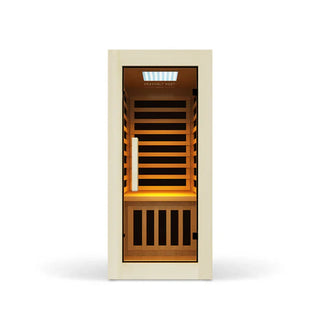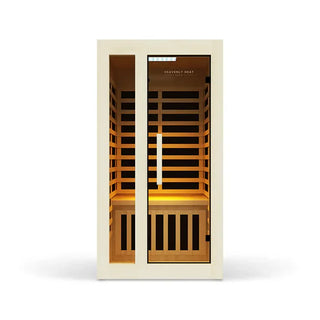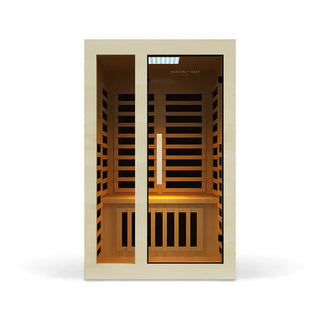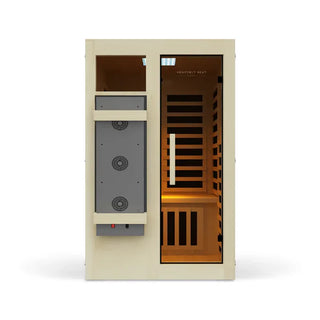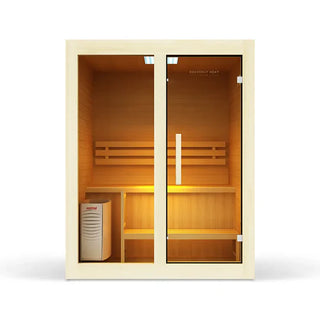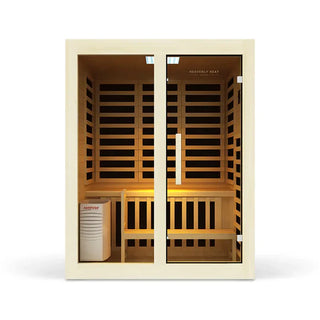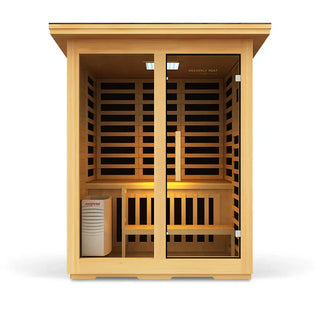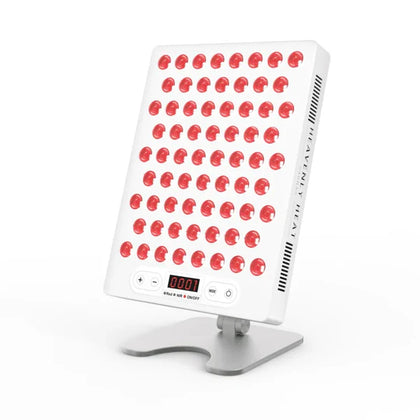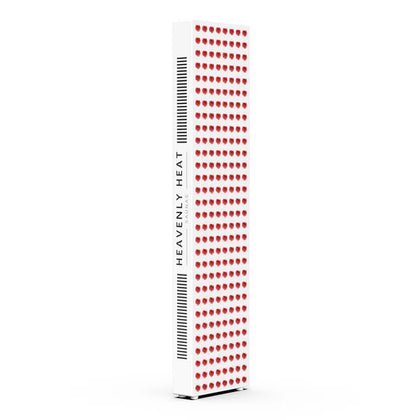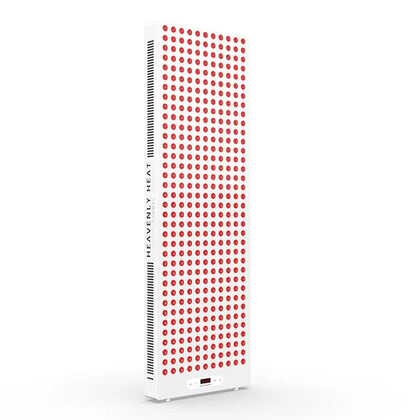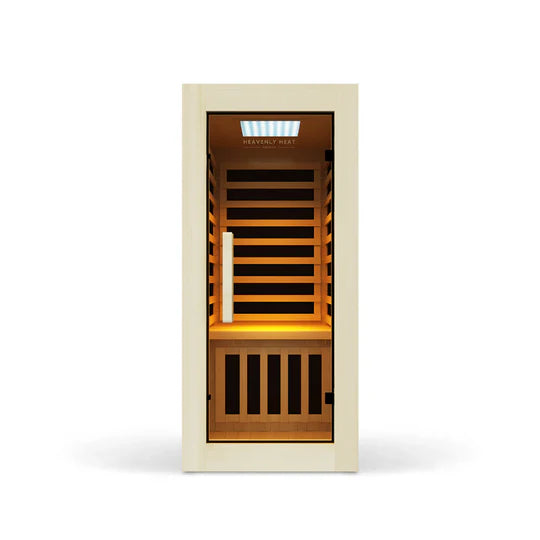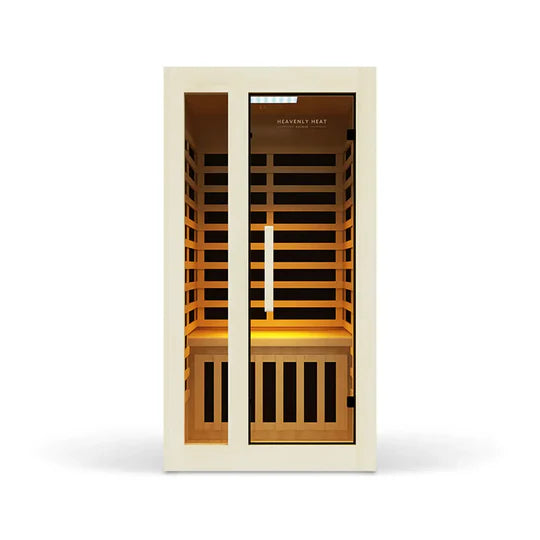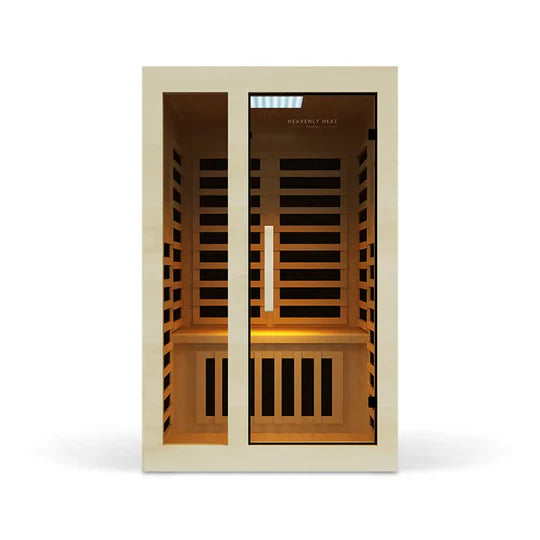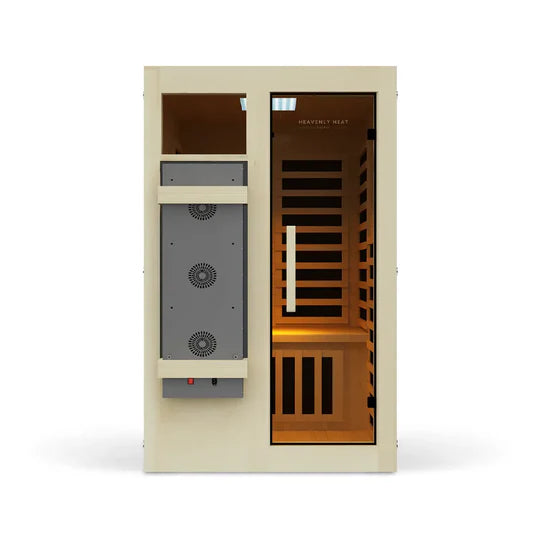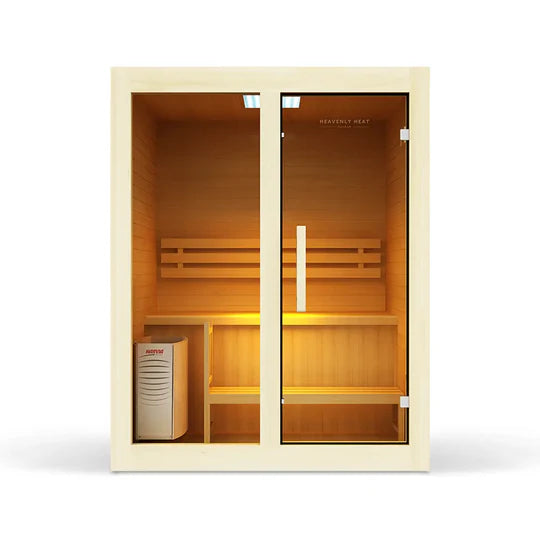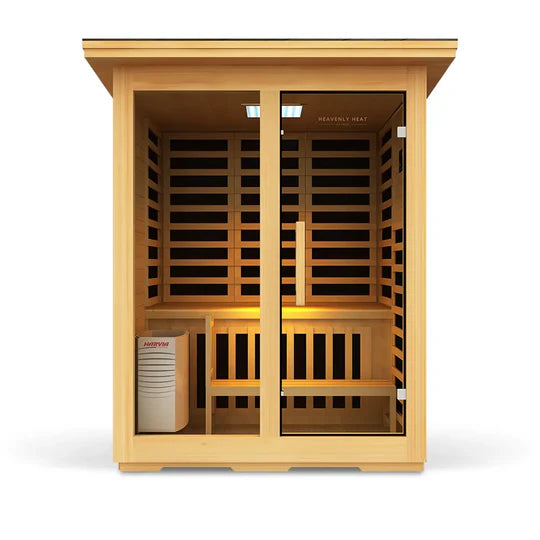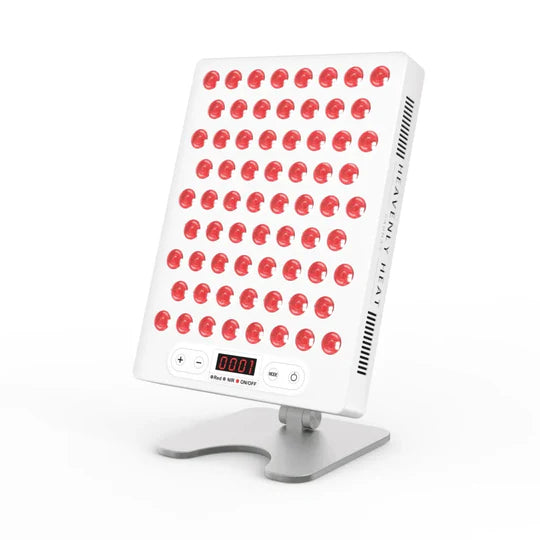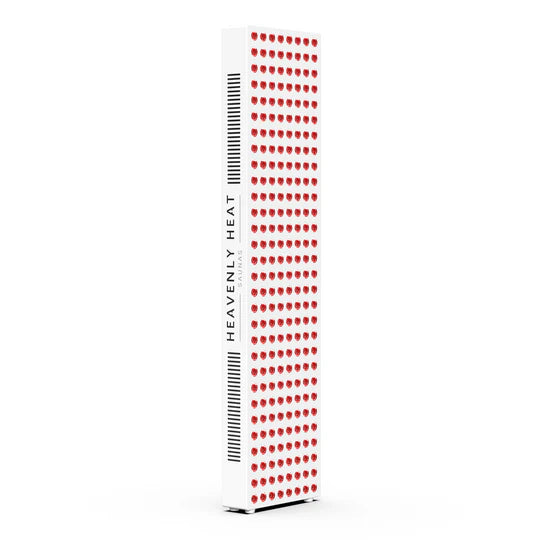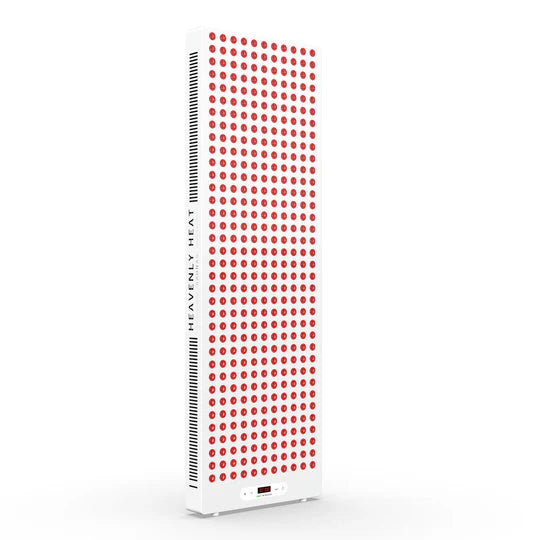Top 5 Benefits of Sauna After Workout

Many fitness experts think that using a sauna after a workout can make your exercise routine even better. But, do you know why?
Using a sauna after a workout is crucial for weight loss, reducing muscle tension, speeding up muscle recovery, and promoting relaxation. Some research even indicates it’s beneficial for heart health.
In this article, we discuss different types of saunas and five potential benefits of taking a sauna after a workout.
Types of saunas
Dry sauna
A dry sauna is a wooden room with a heater designed to create warm conditions inside. This setup helps people inside to sweat, and it is associated with various health benefits.
Infrared Saunas
Infrared saunas and dry saunas look alike with their wooden rooms and heaters. However, they differ in approach—unlike dry saunas, an infrared sauna uses a heater that emits radiant heat, directly warming your body instead of heating the surrounding air.
A wet/steam sauna
For centuries, people have used steam rooms for relaxation, sports recovery, and health benefits. A steam sauna, or steam room, involves the use of a generator filled with boiling water to create a hot and steamy environment. These facilities are typically found in gyms, spas, hotels, and resorts.
Choosing the Best Sauna for You
Saunas come in different types, and picking the right one depends on your needs. Traditional saunas use heated rocks to create a dry, intense heat, while infrared saunas warm the body directly with infrared light, making them gentler. If you love steam, a steam sauna provides high humidity, unlike dry saunas, which have little to no moisture. For home use, infrared saunas are energy-efficient and easy to install. Wood-burning saunas give an authentic experience but need more space and upkeep, while electric ones heat up faster. If space is tight, an indoor sauna works best, but outdoor saunas offer a more natural escape.
Benefits of Sauna After the Workout
Helps in weight loss
Saunas can be a great tool to help with weight loss in several ways. They help you sweat out excess fluids, which temporarily reduces your body weight. For example, a study on overweight men found that 60 minutes of sauna sessions led to a loss of 0.65 kg, highlighting how fluid loss contributes to weight reduction.
Saunas also increase your heart rate and energy expenditure, which helps burn more calories during the session. It’s similar to how your body reacts during light exercise. The heat makes your body work harder, which helps with calorie burning and weight loss.
Additionally, saunas promote better recovery by relaxing muscles and reducing stress, which helps you stay consistent with your exercise routine.
While saunas can support weight loss, they aren’t the most effective method. Relying only on saunas won’t lead to lasting results. Combine sauna use with healthy habits like regular exercise, a balanced diet, and proper hydration for the best outcomes. Saunas are a helpful tool, but they work best alongside other weight loss strategies.
Ease muscle soreness
After a tough workout, your muscles can feel sore because exercise causes tiny tears in muscle fibers. This soreness often feels like stiffness, tenderness, or even pain when you move.
It’s your body’s natural response as it heals and builds stronger muscles, but it can leave you feeling uncomfortable and drained. This is where a sauna comes in. According to a study, spending 20 minutes in an infrared sauna after exercise significantly reduces muscle soreness. The heat improves blood flow, which helps flush out waste products like lactic acid while bringing in nutrients to repair the muscles. It also eases tension, helping your body relax and recover faster. Along with sauna sessions, you can also try foam rolling, stretching, or a cold shower to further reduce muscle soreness and bounce back stronger.
Ensure Good Heart Health
Your heart is the engine of your body, pumping life into every cell. Taking care of it is essential for living a healthy, active life. Poor heart health can lead to issues like fatigue, shortness of breath, or even serious conditions like heart disease. Saunas can play a surprising role in keeping your heart in top shape. A study from Finland found that frequent sauna sessions (4–7 times per week) significantly lowered the risk of sudden cardiac death, fatal heart disease, and cardiovascular-related deaths. Saunas improve circulation by causing blood vessels to widen, reducing strain on the heart.
However, if you have a condition like high blood pressure, consult your doctor first. According to the American Heart Association, saunas are generally safe if your blood pressure is under control.

Helps your body to recover after intense exercise
"I'm a big proponent of adding heat after a workout, for everything from health reasons to performance," says Dr. Christopher Minson, a leading researcher in thermoregulation and cardiovascular physiology.
After an intense workout, your muscles may feel sore and fatigued. The sauna can be a game-changer in helping your body recover. The heat from the sauna boosts blood flow to your muscles, delivering oxygen and essential nutrients that speed up recovery. A study on male basketball players showed that after a tough workout, those who used an infrared sauna (IRS) experienced less muscle soreness and better recovery compared to those who only rested. The heat from the sauna also helps remove metabolic waste, like lactic acid, which can contribute to muscle pain. The sauna’s heat improves circulation, helps muscles relax, and reduces stiffness, so you feel more at ease and ready for the next challenge.
It Helps You Mentally Relax
After a challenging workout, your mind may feel foggy and fatigued. The sauna can be an excellent way to clear that mental haze and boost your focus. The heat helps your body relax, easing mental stress and calming your mind. As your body unwinds, brain fog lifts, helping you think more clearly and focus better.
Research backs this up. A study found that using the sauna led to increased brain activity and improved mood. Participants showed higher theta and alpha brain waves, linked to relaxation. In fact, brain activity related to attention decreased, meaning the brain became more efficient, making it easier to focus. This change also led to faster response times in tasks.
Another study shows that saunas can also improve sleep. After a sauna session, participants reported better physical relaxation and sleep quality. The heat and relaxation effect not only clear your mind but also set the stage for a deeper, more restful night’s sleep. So, sauna use not only helps you feel more alert after a workout but also improves your ability to relax and rest well.
Boosting Metabolism for Weight Loss
After a tough workout, stepping into a sauna can give your metabolism a real boost. The heat raises your heart rate, making your body work harder and burn more calories, even while you sit still.
Sweating in the sauna doesn’t just flush out toxins—it also increases energy expenditure, helping your body burn fat more efficiently. Heat exposure forces your body to cool itself, which requires extra energy and can enhance fat loss over time. Plus, using a sauna after exercise keeps your calorie burn going, improving post-workout metabolism. With regular sessions, sauna use may lead to long-term metabolic improvements.

Negative effects of sauna after a workout
Sauna after a workout can increase the risk of dehydration
A sauna is hot, and it can make you dehydrated, just like hot weather does. After sweating in a workout and even more in the sauna, it’s important to drink plenty of water before and after.
Sauna May Cause Discomfort
Your body, still coping with the physical demands from the workout, might find the intense heat in a sauna a tad overwhelming. During this transition period, your muscles, heart rate, and body temperature are adjusting back to their normal state. Diving right into a sauna could interrupt this process, causing discomfort and potentially distress. So, ensure you take that necessary break and keep your body well-hydrated for a smoother transition.
Overheating
Overheating happens when your body gets too hot and struggles to cool down. After a workout, your body is already heated from exercise, and using a sauna can push it beyond safe levels. To avoid overheating, stay hydrated, take breaks if needed, and always listen to your body to prevent any discomfort or danger.
Sauna May Temporarily Decrease Sperm Counts
Studies have shown that regular sauna use can negatively impact sperm count. A study explored how sauna exposure affects sperm production, focusing on sperm count, motility, and DNA packaging. It found that after three months of sauna sessions, men experienced significant reductions in sperm quality, including lower sperm count and motility. Even though these effects were reversed six months after stopping sauna use, it’s clear that high temperatures can disrupt sperm production. So, while saunas are great for relaxation, it’s important to consider their potential impact on fertility, especially if you’re planning to conceive. However, these effects are temporary, so it’s not a major concern in the long run.
Who should avoid saunas?
Saunas are good for health, but if you have issues like high blood pressure, heart problems, open wounds, recent injuries, or if you’re pregnant, talk to your doctor before using saunas. Getting advice from a doctor is important to make sure saunas won’t cause any problems for your health
How long to sit in the sauna after a workout
After a workout, using a sauna can help relax muscles and improve circulation. Experts recommend staying in for 10 to 20 minutes for the best results. However, wait until your body has cooled down and rehydrated before entering to avoid overheating and dehydration
Is it better to do a sauna before or after a workout?
While both pre-workout and post-workout saunas offer benefits, many experts recommend using a sauna after the workout. This is because the heat helps relax your muscles, enhances recovery, and promotes a sense of overall well-being. It’s always a good idea to cool down and rehydrate before entering the sauna to avoid excessive strain on your body.
| Factor | Sauna Before Workout | Sauna After Workout |
| Purpose | Warms up muscles, improves flexibility | Enhances recovery, reduces soreness |
| Hydration Risk | Higher (can lead to dehydration before exercise) | Lower (if rehydration is prioritized) |
| Muscle Recovery | Not ideal | Great for reducing soreness & improving circulation |
| Performance Impact | Might cause fatigue before exercise | Helps relax & restore energy post-workout |
| Best For | Light stretching, pre-workout prep | Post-workout relaxation & recovery |
What to wear in the sauna after a workout?
During your sauna session, it’s advisable to avoid tight-fitting clothing and opt for loose-fitting cotton or linen clothing. This allows better air circulation, preventing discomfort. Also, it’s important not to wear items that can be damaged in a sauna due to extremely hot conditions, such as sunglasses, watches, or rings.


